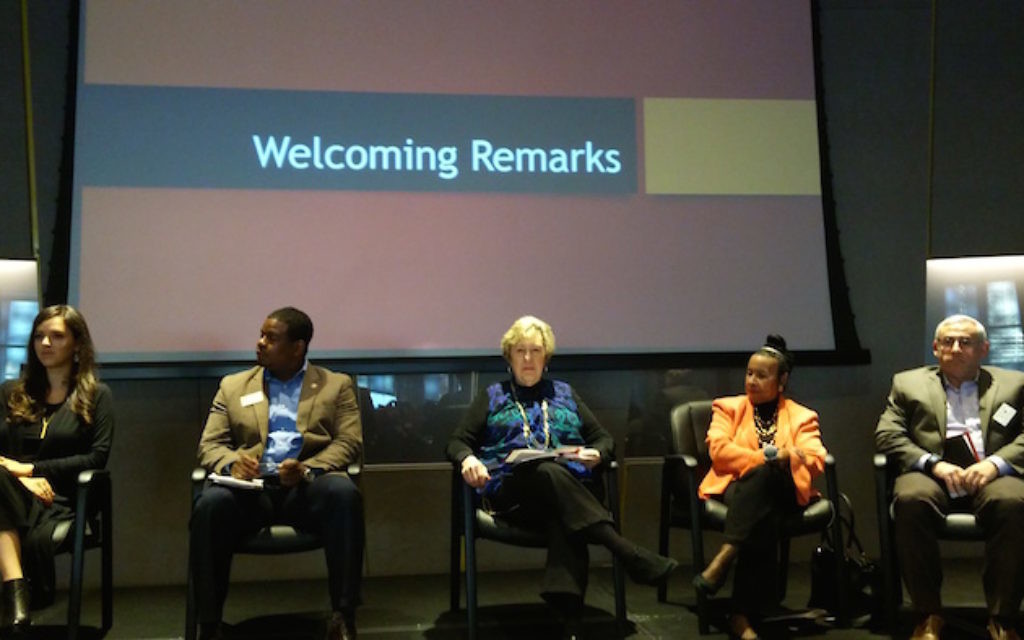Protest With Purpose Requires Alliances
Strength derived from shared experiences gives power to protest

“Protests are meant to bring awareness. Protests are hopes that people that don’t look like us join the fight and join the conversations. Protests have led people to be empowered to become lawyers, police officers and district attorneys.”
So said Tereance Puryear, the president of the Urban League of Greater Atlanta Young Professionals, when asked about the effectiveness of protest.
He was part of a panel discussion hosted by the Black-Jewish Coalition on the power of protest March 20 at the National Civil and Human Rights Center.
Get The AJT Newsletter by email and never miss our top stories Free Sign Up
The panel included Congregation Bet Haverim Rabbi Joshua Lesser, activist Erin Schroeder and civil rights leader Xernona Clayton and was moderated by Sherry Frank, who founded the Black-Jewish Coalition with Congressman John Lewis 30 years ago.
“To look at the energy and enthusiasm of folks who want to continue carrying the torch is very gratifying, particularly in this world with the conversations around division,” Frank said.
People protest out of a need to be heard, and there is power in numbers, Puryear said. Many people think protests are just for show, but he said there is intent behind every step.
“Several protests have made CNN news and world news even. And the conversation was ‘Why are they blocking the roads? Why are they causing this disruption? Why don’t they be quiet? If they were quiet, we would listen to them. We get it,’ ” Puryear said. “You don’t get it. People don’t protest because it’s fun. People don’t walk outside in the rain and mess up their shoes for fun. You’re sweaty, you’re angry, you’re frustrated, and people think it’s all for show.”
Throughout history, protests have aimed to stop racial and economic injustice. With actions such as the Selma-to-Montgomery marches and sit-ins, Martin Luther King Jr. and civil rights activists proved that protests are essential to social movements.
Clayton has been involved in many protests during her lifetime, going back to the civil rights actions in the 1960s. She was also instrumental in desegregating hospitals in Atlanta.
Clayton shared her story to provide attendees with a different form of protest: going to the top.
“Black women could only get the good treatment on Wednesdays,” Clayton said. “It was like if they were pregnant, they better go into labor on Wednesday. Even in the waiting room they wore color wristbands signifying how much income everybody had.”
While researching the issue in the mid-1960s, Clayton learned that the discrimination in Atlanta was funded by the federal government: Hospitals practicing racial discrimination got more federal money than other hospitals in the South and the nation.
“I decided we didn’t need to be fighting them; we needed to fight our federal government,” Clayton said. “We had the largest press conference of any group that had come to Washington, so we got special attention.”
Clayton wrote a letter to President Lyndon Johnson but didn’t get a response. When her group went to Washington, she tried to call the president, and he eventually called back.
Their conversation was the beginning of equal care and treatment for blacks in Atlanta hospitals and at medical facilities across the United States.
Most protests, especially those challenging systemic processes established to oppress others, require support from outside groups. Rabbi Lesser said that’s why he is adamant about social justice activism and encourages it among his congregants at Bet Haverim.
Rabbi Lesser became active in social justice while working with people who have disabilities. He said the acceptance he received was instrumental in his life moving forward.
“I was also in the process of coming out, and the acceptance I received from that community and the partnerships nourished my soul,” Rabbi Lesser said. “That led me to be active in racial issues, LGBTQ issues and women’s issues.”
The strength derived from shared experiences gives power to protest. Unity can only come from the community, Puryear said, and change will happen only when neighbors get together to stop injustice.
“We saw the whole community come out for the women’s march. I think my issue as a black male in society is when it’s a black issue, there are only black faces in the struggle to get things to go right,” he said. “For me, it’s about understanding how we can deaden these issues about blacks in society being viewed very, very differently. From every other race, we’re viewed differently. It’s not on us to answer the question. It’s on society to step up and say what is the issue and how can I help.”




comments